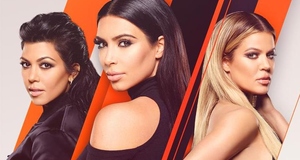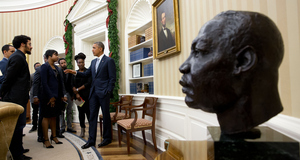International Travel, Nation-Branding, and Orientalism: Conflicting Portrayals of Americanism in The Amazing Race
By
2015, Vol. 7 No. 03 | pg. 2/2 | « As contestants go to board rickety trains and squeaky hot busses, Keoghan describes their journey through the streets of India to the airport as an adventure where the contestants have no idea what will await them. Contestants are shown navigating through crowded streets that are full of flying dust, rats and dirty children. Harvey (2006) has also noted that countries such as India are shown on The Amazing Race as dirty, disorganized, and “without any regard for sanitation or safety” (p. 216). In “The Unexpected Twist” (Doganieri & Van Munster, 2001), the Indian train system “disgusted Nancy” and contestants complain of the sand and the filth around them. Quite different from the scenes of Tanzania’s nature in “I Didn’t Make Her Cry” (Doganieri & Van Munster, 2012) described above, the scenes of the streets of India show the opposites of what the American contestants value and experience at home, such as organized infrastructure and transportation and clean water. Contestants struggle with these unappealing settings which in a way “reassure[s] audiences at home that things are good in the US, that the American Dream is intact” (Roy, 2007, p. 589). In positioning the United States as safer, cleaner, and superior, these images of countries being dangerous, dirty, chaotic, and unpredictable are “unusual to our capitalistic society” and reinforce stereotypes of impoverished and foreign countries (Harvey, 2006, p. 215). By “magnifying the oddities” of other cultures, The Amazing Race “allows America to set itself apart from the non-Western world” (p. 225). Lastly, othering and the ideology of a globally dominant United States are also expressed in The Amazing Race by contrasting American contestants and locals through language barriers. As the American contestants are all English speakers, “On numerous occasions … frustrated characters exclaimed, ‘Why doesn’t anyone speak English here!’” (Mathews, 2012, p. 261). These language barriers, which cause contestants to get frustrated with people who do not speak English, further demonstrate that The Amazing Race displays the world through an American perspective and positions the Western world and its habits as normal. In “The Unexpected Twist” (Doganieri & Van Munster, 2001) contestants Nancy and Emily struggle with language barriers. While searching for a parked car in Thailand they attempt to ask a number of locals where a certain street is. One man silently points to a dead end, leading Emily to screech “God where, where is it?” Nancy then tries to get a local’s attention by saying “ma’am” repeatedly, but the local ignores her and Nancy turns away shaking her head. Less than a minute later Emily asks a man “How far? We’re walking, how far?” making a walking motion with her hands. When the man does not respond Emily says “screw you” and walks away.Similarly, in “Here Comes the Bedouin!” (Doganieri & Van Munster, 2006), teammates Ray and Yolanda struggle with the Arabic language in Oman. While trying to navigate the streets of Muscat and Sur, a frustrated Ray says “I don’t know what kind of language they speak out here, but I can’t even look at this and figure out what it says, they’re all squiggly” and “The signs are confusing as hell.” Through these language barriers contestants experience tension “between their American identity and the diverse cultures they encounter on the trip” (Mathews, 2012, p. 256), and this tension works to contrast the American contestants and the locals and define them as the Self and the Other. In a similar fashion to the way popular American reality show Wife Swap contrasts classes using “extreme characters,” these language barriers create an “‘opposition between normality and difference’” (Lyle, 2008, p. 321). This makes it clear who the Americans are and who the often misunderstanding locals are. The Self “is the familiar” and “is constructed as positive term” (Moosavinia et al. 2011, p. 105) just as how in The Amazing Race the American contestants and the English language are the familiar protagonists. The Other “is strange” and “is constructed as [the Self’s] negative reflections” (p. 105), just as how the locals that contestants approach for guidance speak unfamiliar languages and usually are unable to help contestants, instead becoming a source of frustration. The Amazing Race portrays two conflicting ideologies: the first promotes global travel, encouraging American audiences to explore the world; the second explores what it means to be American by positioning the United States as a globally dominant nation. Both of these ideologies are created by placing American contestants in foreign countries in which they must navigate through unfamiliar cities and landscapes completing tasks characteristic of each country. The first perspective, that which glorifies travel, relies heavily on comments from contestants about how travelling the world is a special, once-in-a-lifetime, life-changing experience. The second perspective positions the United States at the top of Roy’s (2007) “hierarchy of nations” (p. 570). This ideology relies heavily on acts of Orientalism, which through developing a Western self-image portrays that identity as “superior to all other cultures and peoples” (Moosavinia et al., 2011, p. 105) through the omission of locals’ voices, negative stereotypical depictions, and language barriers. While The Amazing Race can work to encourage Americans to explore the world beyond the United States (Mathews, 2012, p. 265), it is also “a show that can easily fall into an age-old rut of belittling other people and cultures in an attempt to lift up America and Americans” (Gray, 2013, p. 101). ReferencesDoganieri, E., & Van Munster, B. (Writers). (2001, November 14). The unexpected twist [Television series episode]. In The amazing race. New York, NY: CBS. Doganieri, E., & Van Munster, B. (Writers). (2006, April 16). Here comes the Bedouin! [Television series episode]. In The amazing race. New York, NY: CBS. Doganieri, E., & Van Munster, B. (Writers). (2012, April 8). I didn’t make her cry [Television series episode]. In The amazing race. New York, NY: CBS. Gray, J. (2013). The Amazing Race: Global othering. In E. Thompson, & J. Mittell (Eds.), How to watch television (pp. 94-102). New York: NYU Press. Harvey, J. (2006). The amazing “race”: Discovering a true American. In D.S. Escoffery (Ed.), How real is reality TV? Essays on representation and truth (pp. 212-227). Jefferson, NC: McFarland & Company. Kuppens, A., & Mast, J. (2012). Ticket to the Tribes: Culture shock and the ‘exotic’ in intercultural reality television. Media, Culture & Society, 34(7), 799-814. doi: 10.1177/0163443712452769 Lyle, S.A. (2008). (Mis)recognition and the middle-class/bourgeois gaze: A case study of Wife Swap. Critical Discourse Studies, 5(4), 319-330. doi:10.1080/17405900802405239 Mathews, S.A. (2012). Disrupting the amazing race: Education, exploration, and exploitation in reality television. Theory & Research in Social Education, 37(2), 247-272. doi: 10.1080/00933104.2009.10473396 Moosavinia, S.R., Niazi, N., & Ghaforian, A. (2011). Edward Said’s Orientalism and the study of the self and the other in Orwell’s Burmese Days. Studies in Literature & Language, 2(1), 103-113. Retrieved from http://www.cscanada.net/ Muspratt, M., & Steeves, H.L. (2012). Rejecting erasure tropes of Africa: The Amazing Race episodes in Ghana counter postcolonial critiques. Communication, Culture & Critique, 5(4), 533-540. doi:10.1111/j.1753-9137.2012.01143.x O’Shaughnessy, M. (1990). Box pop: Popular television and hegemony. In A. Goodwin, & G. Whannel (Eds.), Understanding television (pp. 88-102). New York: Routledge. Roy, I.S. (2007). Worlds apart: Nation-branding on the National Geographic channel. Media, Culture & Society, 29(4), 569-592. doi:10.1177/0163443707076190 Winslow, L. (2010). Comforting the comfortable: Extreme Makeover Home Edition’s ideological conquest. Critical Studies in Media Communication, 27(3), 267-290. doi: 10.1080/15295030903583549 Suggested Reading from Inquiries Journal
Inquiries Journal provides undergraduate and graduate students around the world a platform for the wide dissemination of academic work over a range of core disciplines. Representing the work of students from hundreds of institutions around the globe, Inquiries Journal's large database of academic articles is completely free. Learn more | Blog | Submit Latest in Business & Communications |
















